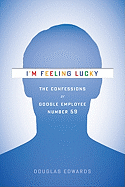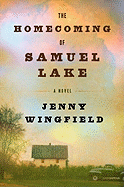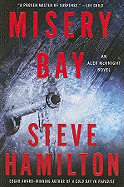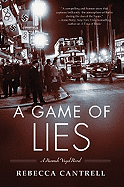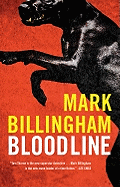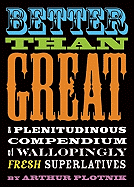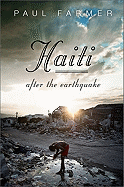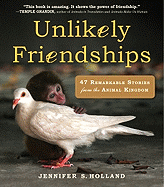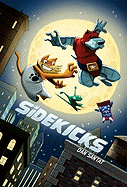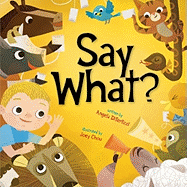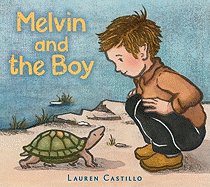This week saw the release of Glen Duncan's The Last Werewolf, which we covered in a Maximum Shelf--so don't worry, I'm not going to talk about the book again here. (Although I do recommend it.)
Partly because of this book's release, several people have asked me why I think we're all so entranced by vampires, zombies, robots, witches, werewolves, ghosts, et al. There are probably as many reasons as there are varieties of supernatural beings, but the one that leaps immediately to my mind is quite simple: contrast.
Years ago, I taught English composition, and the classic "compare and contrast" essay was one of my instruments of torture, er, I mean, teaching tools. I remember telling students that this form of argument was particularly effective because it mimics the process we all go through, whether choosing which car to buy or which course to take. But I also told them to remember that a writer doesn't have to convince herself of how valid a comparison is; she has to convince a reader.
Now, in fiction, writers are rarely trying to sell you something. Hahaha! Of course they are trying to sell you something: they want you to buy in to their premise. What's one of the fastest ways to make a character different? Make him magical. You might not read thousands of pages about a young English boy navigating his way through prep school, his best friends a wonk and a dork. However, give that boy a wand and faster than you can say "Wingardium leviosa!" you have the Harry Potter series--with its all-encompassing world.
 For the record, I read those thousands of pages, and thoroughly enjoyed each and every one. There are plenty other books about supernatural beings that leave me colder than Bellatrix Lestrange's heart, but that's okay; they might warm yours. I believe that that contrast is somewhat magical. --Bethanne Patrick
For the record, I read those thousands of pages, and thoroughly enjoyed each and every one. There are plenty other books about supernatural beings that leave me colder than Bellatrix Lestrange's heart, but that's okay; they might warm yours. I believe that that contrast is somewhat magical. --Bethanne Patrick
The Homecoming of Samuel Lake
by Jenny Wingfield
As I devoured this spectacular debut novel, I couldn't help but think of the film To Kill a Mockingbird. The title character's spunky 11-year old daughter, Swan Lake (who rises above her name), is reminiscent of Scout, and screenwriter Jenny Wingfield (The Man in the Moon) has written an unforgettable 1950s Southern tale that would lend itself perfectly to a movie. (In fact, if this work isn't made into a motion picture I'll eat my hat with a side of grits.)
Samuel Lake, a preacher who has lost his parish, moves in with his beloved wife's quirky relatives, including sassy mother-in-law Calla, damaged brother-in-law Toy and a femme fatale sister-in-law determined to have Samuel for her own. Despite the dysfunction, there is abundant love within the family. That love and Samuel's very faith are tested when they encounter the chilling and remorseless Ras Ballenger. When this monster inflicts a sinister act beyond anyone's wildest imaginations, the family takes a stand--with dire consequences.
The book's captivating setting, authentic characters and enthralling plot make for an engrossing read that's both addictive and uplifting, despite several instances of violence that are not for the weak of stomach.
This tale of family loyalty and miracles will stay with you as Wingfield examines the question of exactly what we are willing to sacrifice for those we love. The Homecoming of Samuel Lake draws you in so completely you won't be able to put it down. --Natalie Papailiou, author of blog MILF: Mother I'd Like to Friend
Discover: Screenwriter Jenny Wingfield's moving, memorable debut novel about family, faith and forgiveness set in 1950s Arkansas.
Mystery & Thriller
Misery Bay
by Steve Hamilton
In this tale of gripping suspense, author Steve Hamilton returns to Paradise, Mich., for the eighth installment in his Alex McKnight mystery series. Sault Ste. Marie police chief Roy Maven and private investigator Alex McKnight have not always seen eye-to-eye in the past, but when Maven's former partner, Charles Razniewski, is too preoccupied with the peculiar circumstances of his son's death to move past his grief, Maven reluctantly approaches McKnight for help. It is with equal reluctance that McKnight, unable to move on from the grief caused by his own recent loss, agrees to investigate the three-month-old case of Charles Razniewski, Jr.'s apparent suicide near Misery Bay. He returns home from his investigation and finds the elder Razniewski murdered on Maven's kitchen floor. When McKnight and Maven team up to find the killer, they uncover the missing thread of a connection between the two deaths and other recent murders of law enforcement officers whose children, allegedly, have also committed suicide. To the pair's utter horror, they quickly discover that if they don't catch the killer soon, this tenuous thread will lead him to kill again--this time, too close to home.
Misery Bay is an electrifying adventure from start to finish, with clever heroes, disturbing villains and their seemingly uninhabitable surroundings advancing the chilling mystery. The intricate plot and various twists and turns will keep the reader guessing from the first unsettling clue all the way to the story's satisfying end. Two-time Edgar winner Steve Hamilton has created another evocative page-turner that will not disappoint faithful fans of the Alex McKnight books. --Sarah Borders, librarian, Houston Public Library
Discover: The latest enthralling thrill ride in a place so grim and with a villain so unhinged it could only be Alex McKnight's Paradise, Michigan.
A Game of Lies
by Rebecca Cantrell
Intrepid German reporter/spy Hannah Vogel is back in Rebecca Cantrell's A Game of Lies, her third mystery set in 1930s Berlin. Posing as a Swiss journalist, Hannah sneaks back into Berlin to cover the 1936 Summer Olympics, and to meet with her mentor about a package he needs couriered out. The meeting goes awry, people die, and Hannah, hunted by the Gestapo, risks her life to find the mysterious package.
Cantrell, who studied in Berlin, easily drops the reader into Nazi Germany. She weaves period details and real people into the story, making it both fascinating and educational. Readers may not know that the only Jewish athlete allowed to compete for Germany in that year's Olympics was Helene Mayer, a fencer, and though Jesse Owens's gold-medal wins are old news, reading about the "Negro's" triumphs on Aryan soil is still satisfying.
Cantrell maintains a sense of danger throughout, not just for Hannah but for anyone who dares defy the Nazi doctrine. This makes it impossible for the reporter to trust even long-time friends fully. Further complicating her mission is her growing attraction to the SS officer Lars Lang, who poses as her lover and helps her spy for the British. Not only are his motives questionable, but he struggles with alcohol and his temper. Hannah's feelings toward Lang are fraught with red flags, but the tension between them is surprisingly sexy. Hannah's actions risk making her young son an orphan, but her fight for a better world is noble, and her perseverance is something to admire. --Elyse Dinh-McCrilllis, chief nerd and blogger at Pop Culture Nerd.
Discover: An absorbing tale of espionage set in Berlin during the 1936 Summer Olympics.
English Tea Murder
by Leslie Meier
Lucy Stone--reporter for the Tinker's Cove, Maine, Pennysaver--is taking her first trip across the Atlantic. The tour of England, led by a local professor, is a chance for Lucy and her friends Rachel, Pam and Sue to see something of the world. When one of the tour members dies before the plane has even landed, Lucy can't help but wonder whether the death was indeed an unfortunate accident.
As she pokes around the Tower of London, bargains with vendors at Portobello Market and walks the pier at Bath, Lucy observes her fellow travelers and is left feeling uneasy. Is she allowing thoughts of a conspiracy get the better of her? After a couple of unexplained accidents and a second death, Lucy--and the police--are on the case.
Whether this is your introduction to Lucy Stone or you're caught up with the series, you'll find Leslie Meier's English Tea Murder a great escape. You'll sympathize with Lucy as she adjusts to the foods and customs of modern England and might be envious as she explores historic sites and shops in Harrods. Throughout the trip, however, Lucy can't shake the idea that she witnessed a murder, even though none of the Americans--including a grieving mother, troubled college students and a medical doctor--seems to have means or motive. Thanks to the complex relationships among the characters and an unexpected dilemma for Lucy, you'll find it difficult to predict the ending of this satisfying cozy. --Candace B. Levy, freelance editor blogging at Beth Fish Reads
Discover: Lucy Stone's latest adventure takes her across the ocean; instead of tea and scones, she finds unpalatable food, cagey tourists--and a spot of murder.
Bloodline
by Mark Billingham
American fans of Mark Billingham have had to wait almost two years to get the eighth installment in the Detective Inspector Tom Thorne series. The follow-up to Death Message, Bloodline came out in the U.K. in August 2009. Fans will find the wait well worth it.
Thorne is a London DI in his 40s, a member of the Metropolitan Police Murder Squad. He likes country music; his girlfriend, Louise Porter; and his best friend, Phil Hendricks, a gay, tattooed pathologist. He's tough but has feelings, and he's now dealing with a loss--Louise's miscarriage.
The book opens with a distraught mother taking her young son to a bridge where a train is fast approaching. Why? Cut to the hospital where Louise is; then cut to Thorne's new case, a strangled woman holding a piece of x-ray film in her hand. Why? Then cut to another murder and another piece of film. Gradually we learn that these victims are the children of serial killer Anthony Garvey's victims from years ago. Who is this new killer following in the perverse footsteps of the deceased Garvey? Is there a clue in the book's title? Billingham now has you in his grasp, and it's a firm one.
Billingham continues to grow as a novelist. He's in better control of his narrative and plots and his dialogue continues to be one of his strengths. Thorne is on his way to becoming one of the U.K.'s best (believable) fictional detectives. And American fans will have to wait again--for the BBC's new Thorne series. --Tom Lavoie
Discover: The latest in the DI Thorne series--a winner.
Nonfiction
Better Than Great: A Plentitudinous Compendium of Wallopingly Fresh Superlatives
by Arthur Plotnik
Until recently, if a wordsmith or conversationalist wanted to convey an emotion in an over-the-top way--but felt awesomely tongue-tied (or awesomely tired of "awesome")--he or she had to rely on boring search engines or old-school dictionaries. Then, along comes this delightful, spankingly amusing little book from Arthur Plotnik, author of The Elements of Editing.
We have used our pleasant superlatives to death, says Plotnik. Fabulous is often said sarcastically. Unbelievable is trite. Incredible is boring. Spectacular is no longer all that great--and neither is great. Conversation is peppered with these words so much that they've lost their ability to capture the intended meaning and, to compensate, we feel a need to add on intensifiers: So great. Too cool. Totally awesome. Or we drag out a word until it's just aMAYYYYzing.
Using 15 generally generic ways of conveying basic goodness, as well as some appendices to help further a newfound lingual insouciance, Plotnik presents hundreds of words and phrases that will make any conversation a sojourn through paradise. This will make your words grovel-at-the-feet divine. Your listeners will find you pawky. They'll hang onto your every word with bum-clenching tenseness. You'll suddenly feel like you're in Celebrity City. And if you're a linguist, conversationalist, writer or just like quirky etymology books, this book is DAP. --Terri Schlichenmeyer, writer at The Bookworm Sez
Discover: A fun way to throw out old words and spice up your conversation, courtesy of long-time editor and writer Arthur Plotnik.
I'm Feeling Lucky: The Confessions of Google Employee Number 59
by Douglas Edwards
In I'm Feeling Lucky, Doug Edwards provides an engaging and entertaining inside look at how Google went from Silicon Valley start-up to a sprawling, S-1 corporation employing tens of thousands in just seven years. Edwards closes his work with these words: "After Google, I find myself impatient with the way the world works. Why is it so hard to schedule a recording on my DVR? Why aren't all the signal lights synched to keep traffic flowing at optimum speed? These are... solvable problems. Smart people, motivated to make things better, can do almost anything. I feel lucky to have seen first hand just how true that is."
What saves this memoir from becoming an insufferable love letter to his former employer is Edward's unusual position: a brand marketer in a company that disdains brand marketing. At Google, engineers rule and believe if they build the best product, users will come. Edwards, an outsider in many regards, is not afraid to point out the hubris of the company's founders, Larry Page and Sergey Brin, who emphasize "efficiency, frugality, integrity" above all else.
I loved reading about Google's journey from an unknown search engine into an indispensable aspect of our daily lives. This peek at the masterminds behind Google is fascinating, as is learning about its corporate culture--playful and creative, yet competitive and extremely demanding.
Edwards is an English major with a great sense of humor, and readers do not need a technical background to enjoy I'm Feeling Lucky. This winning book belongs on the reading list of every entrepreneur, business student and, well, Google user, which is just about everyone. --Kristen Galles at Book Club Classics
Discover: An engaging, entertaining peek behind the curtain at Google.
Haiti After the Earthquake
by Paul Farmer
Anyone who has read Tracy Kidder's Mountains Beyond Mountains already knows that Paul Farmer is a rare individual who not only seems to have more than 24 hours in his day, but spends those hours focused on the betterment of others, especially the disenfranchised.
Haiti After the Earthquake is Farmer's comprehensive study of why the 2010 earthquake was largely an "unnatural" disaster that has been challenging to overcome. Farmer asserts that "rebuilding capacity--public or private--in Haiti requires sound analysis of what, exactly, has gone so wrong over the past four decades." Farmer's history of Haiti--the first successful slave revolt that lead to the first black republic--illustrates the tenacity and determination of its people. He then discusses why Haiti's "history of outsourcing almost every project to NGOs and contractors made trying to help the public sector like trying to transfuse whole blood through a small-gauge needle, or in popular parlance, to drink from a fire hose" and has made "building Haiti back better" difficult.
After describing the often disheartening attempts to rebuild Haiti, Farmer suggests the successful reconstruction of post-genocide Rwanda may serve as a model for Haiti, and then examines best- and worst-case scenarios for Haiti, circa 2015.
Haiti After the Earthquake provides a complex, wholly accessible study of the factors driving Haiti's future. -–Kristen Galles, blogger at Book Club Classics
Discover: A must-read for anyone who hopes to gain greater perspective and wisdom regarding Haiti's complex past and future.
Unlikely Friendships: 47 Remarkable Stories from the Animal Kingdom
by Jennifer S. Holland
In need of a feel-good book for the summer? Know an animal lover who is having a birthday soon? Want to explore a bit of quirky natural history with your kids? If so, Jennifer Holland's new book, Unlikely Friendships: 47 Remarkable Stories from the Animal Kingdom, is for you.
Holland, a senior writer for National Geographic magazine, has researched stories of relationships between animals of different species and collected 47 of them in a book consisting of brief, easily readable vignettes accented with full-color photographs. Each chapter concisely describes the history of a particular interspecies bond, the unique qualities of the relationship and the eventual outcome of the pairing. Most chapters include more than one descriptive photograph, and all chapters contain information on animal classification. A reference section at the end of the book provides bibliographic material and resources for further study.
Some of the animal pairings will be familiar to readers from previous publications, including Koko the gorilla with All Ball the kitten and Mzee the giant tortoise with Owen the hippo. Other pairings, though, are almost unbelievable, especially when bonding occurs between animals that would normally be predator and prey. Unlikely Friendships will hold interest for readers of all ages and would be particularly suited to a shared reading between adults and children, as the book encourages animal identification, exploration of animal behaviors and discussion of relationships and their outcomes. It will be a rare reader that puts this book down without pondering the power of friendship. --Roni K. Devlin, owner, Literary Life Bookstore & More
Discover: A collection of 47 compelling stories about interspecies friendships, accented with full-color photos, animal identification information and a reference section.
Machiavelli: A Biography
by Miles J. Unger
Niccolò Machiavelli (1469-1527) was labeled "the finger of Satan" by a prominent Cardinal in 1539, and his work was placed on the Papal Index of Prohibited Books in 1559. Miles Unger chronicles Machiavelli's rise to notoriety with the same flair that he brought to Magnifico: The Brilliant Life and Violent Times of Lorenzo de' Medici. From humble beginnings in Florence to his bureaucrat years and fame, on to his posthumous vilification by the Church, Machiavelli's life is observed with a Renaissance-like attention to detail.
As Florence's Second Chancellor, Machiavelli observed his city through multiple crises and believed that classical principles of statecraft lagged behind contemporary needs. He was candid to a fault when he wrote The Prince, sharing everything he had learned with the Medici who were coming in to govern Florence, but the powerful family dismissed him as a nuisance. As Unger remarks, The Prince has achieved fame as perhaps the most unsuccessful job application of all time.
"A lie, convincingly told, is among the most powerful weapon in the ruler's arsenal," Unger writes, explaining that Machiavelli did not follow his own tips for rulers. "Pointing out uncomfortable truths turned out to be an unpardonable crime, while countless acts of cruelty, treachery, and violence... were passed over with barely a yawn." Machiavelli should have known what would happen to him for speaking so plainly to the Medici, but could he have had imagined he'd be influential for centuries? Cynic that he was, he'd have laughed and asked how much his monetary award was.--John McFarland
Discover: An engaging, authoritative bio of Machiavelli, who become a world-famous author, founded modern political science and was vilified by the Church--not bad for an government clerk in Renaissance Florence.
Children's & Young Adult
Sidekicks
by Dan Santat
In this suspenseful, often humorous graphic novel, Dan Santat (Oh No! Or How My Science Project Destroyed the World) portrays a superhero running out of steam who decides to hold auditions for a sidekick. His dog Roscoe (aka Metal Mutt!) and Fluffy the hamster believe they're up for the roles, and set out to prove it to Captain Amazing--otherwise known as Harry, their owner. As Roscoe puts it, "Most superheroes dress like animals anyway. He'll just think I'm wearing a fancy dog outfit." When Dr. Archibald Havoc is released on parole and into the streets of Metro City, they all have their work cut out for them. A new addition to the clan, a chameleon that Harry names Shifty, tags along with Fluffy, and they both nearly become dinner to a group of tomcats. Manny (aka "The Claw"), feline former sidekick to Captain Amazing, shows up to set them free, and Fluffy hatches a plan to bring Manny back into the fold.
Santat brilliantly divvies up the pages into panels that speed up and slow down the action like a well-choreographed musical. Warm earth-toned colors, square-jawed heroes and wide-eyed animals call to mind early Hanna-Barbera cartoons. A highlight is a nightclub scene that could be right out of Star Wars except that it's peopled by penguins, rhinos and elephants, and run by a gorilla named Mungo. When a DNA transfer device goes missing, all fingers and paws point to... Dr. Havoc. But can they capture him before he defeats Captain Amazing? Kids will hope that Captain Amazing and his sidekicks will return for many more adventures. --Jennifer M. Brown, children's editor, Shelf Awareness
Discover: A funny and suspenseful new superhero whose furry sidekicks nearly upstage him.
Say What?
by Angela DiTerlizzi, illus. by Joey Chou
In this bouncy, rhyming introduction to animal sounds, Angela DiTerlizzi (the Adventures of Meno series, illustrated by husband Tony DiTerlizzi) imagines secret meanings behind the common "moo" and "baa." A blond-haired boy pictured with his mother starts with a question: "How do we know/ what animals say/ when they say what they say/ with their sounds every day?" Joey Chou (Crazy by the Letters) hints at the creatures to be introduced when they form a semicircle around the boy in the opening image. The first couplet introduces a cow and her calf: "When a cow says moo,/ does she really mean who?" Animal-shaped clouds (a bunny, a fish, an alligator) float in the sky above them. Next come a lion and his cub ("When a lion says roar,/ does he really mean more?") and a horse and colt forming the "hay" equivalent of snow angels ("When a horse says neigh,/ does she really mean hay?"). A trip-off-the-tongue refrain brings the three animals together: "They say what they say/ in their own silly way,/ when they say what they say/ with their sounds every day."
DiTerlizzi similarly introduces two more trios of animals and, at the refrain, shows the group of critters mentioned thus far. One meltingly sweet image in cotton-candy pink depicts a mother sheep peering through a nursery window ("When a sheep says baa,/ does he really mean Ma?") as a wide-eyed lamb reaches his hooves out to her. It ends with the human child relating back to his own mother with a message of love we can all understand. Delightful. --Jennifer M. Brown, children's editor, Shelf Awareness
Discover: A very first book of animal sounds in which a boy imagines the meaning behind each "moo," "baa" and "roar."
Melvin and the Boy
by Lauren Castillo, illus. by Lauren Castillo
You can almost feel the texture in Lauren Castillo's (What Happens on Wednesdays) images of an urban boy who adopts a turtle he finds in the park. The child pines for a pet as he sits on his stoop, watching wagging dogs go by on their walks. "I really want a pet, but I always hear 'No.' " says the boy narrator. The large dog that seems to be walking its master is "too big," says Mom. Dad says a monkey is "too much work." Castillo, in an impressive debut as an author, delivers a deadpan text that plays against her bustling city scenes. "Everyone else has a pet," the boy says while gazing at a leashed gerbil and llama (plus the usual cats and dogs). Then the boy finds a pet that fits the bill--not too big, not too much work: a turtle he names Melvin.
In Castillo's illustrations, the turtle stays true to its nature, much to the hero's disappointment. "Back home I try to play with Melvin, but he is hiding." He continues to "hide" in front of the boy's friends and their pets. Castillo milks the humorous possibilities. As Melvin takes a bath, he comes face to face with a rubber ducky. Still, the young hero can sense that Melvin doesn't seem at home among humans and must make a difficult decision. Castillo closes with two pages of "turtle facts." Her deceptively simple story conveys a child's respect for nature's creatures and also the importance of first-hand experiences with them. --Jennifer M. Brown, children's editor, Shelf Awareness
Discover: A boy's bittersweet first experience as a pet owner.
| Advertisement nuremberg--only in theaters november 7 |


